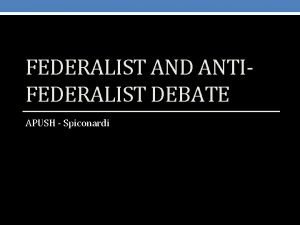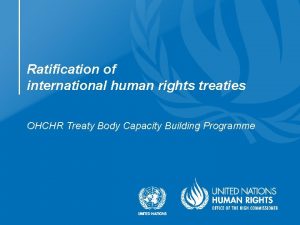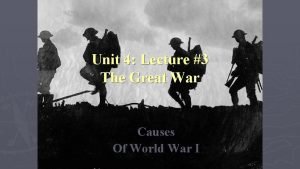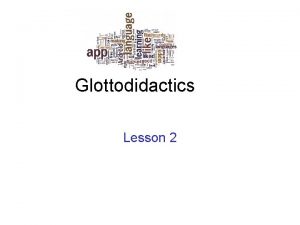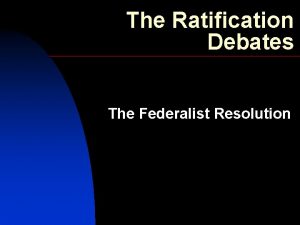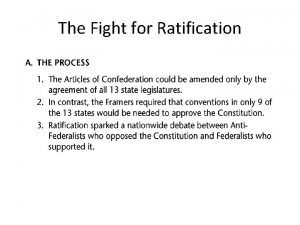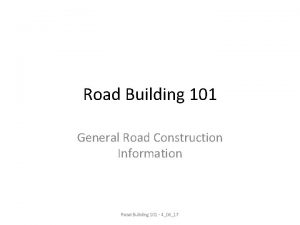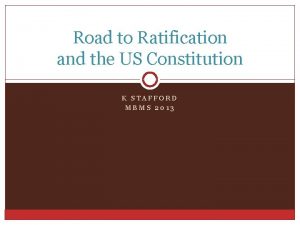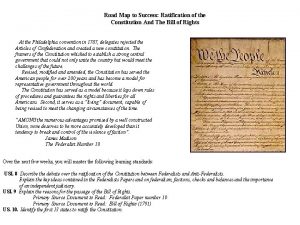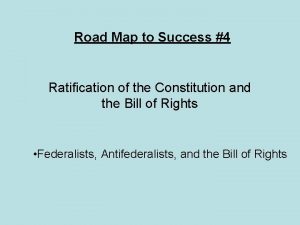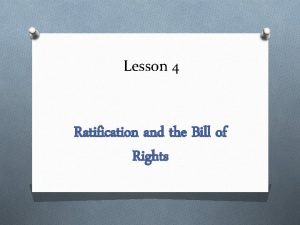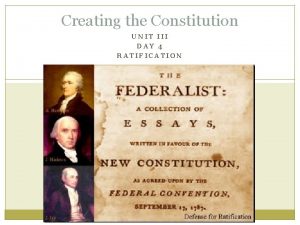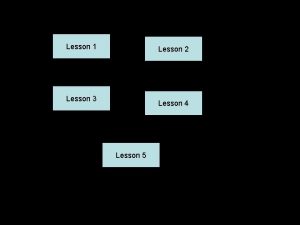UNIT 3 ROAD TO RATIFICATION LESSON RATIFICATION OF

























- Slides: 25

UNIT 3 ROAD TO RATIFICATION LESSON RATIFICATION OF THE SS. 7. C. 1. 8 – Explain the viewpoints of the Federalists and the Anti-Federalists about the ratification of the Constitution.

ROAD TO RATIFICATION OF THE CONSTITUTION § 55 Delegates from almost all the states gathered at the state house in Philadelphia. §This is the same place where 8 of them had signed the DECLARATION OF INDEPENDENCE 11 years earlier. §The delegation elected GEORGE WASHINGTON to preside (supervise) the meeting. §They were meeting to come up with a better plan on running the United States and getting rid of the ARTICLES OF CONFEDERATION.

A New Idea! Articles of Confederation 1 Branch Legislative—makes laws New Idea 3 Branches

Battle of the Plans The Virginia Plan The New Jersey Plan 2 1 • Legislative branch has ___ “chambers” “chamber” • Number of votes for each state depends on the population state’s ______ Larger states would • ____ have more power • Each state gets ___ 1 vote Smaller states would • ____ have more power (Virginia was a large state, and New Jersey was a small state. Surprise!)

THE GREAT COMPROMISE The Great Compromise was an agreement providing a dual system of congressional representation. Congress would have two houses – a Senate and a House of Representatives. In the Senate, each state would have two members. This pleased the smaller states. In the House, the number of seats for each state would reflect the state’s population. This pleased the larger states.

The Constitution Solution Legislative: Makes laws Divide Congress Into Two Houses Senate Each state gets 2 votes. tive: u c e x E ws a l t u so Carrie Judic ial: Inter prets laws House of Representatives The more people the state has, the more votes it gets!

NORTH VS. SOUTH The North had few enslaved persons. Northern delegates argued that enslaved persons were legally property and did not vote or share in government. Therefore, they said, enslaved people should not be counted for representation. The South had many enslaved persons. These states hoped to count the enslaved people in their populations. Then they would have more votes in the House of Representatives.

THREE-FIFTHS COMPROMISE The delegates worked out an agreement called the Three-Fifths Compromise. It provided that enslaved persons would count as three-fifths of other persons in determining representation in the House.

QUICK QUIZ! THE CONSTITUTION SOLUTION

The Articles required states to treat citizens Think from other states the About same as their own It citizens. True False

The Constitution Think requires each state to About treat ____ citizens of other It states the ______ same as it treats its own citizens.

How many states had to agree in order for Think the Articles of About Confederation to be It changed? All states A majority of states

Think About It The Constitution can be changed if ________ two-thirds (2/3) of the members of Congress and ________ three-fourths (3/4) of the states agree.

The Articles of Confederation required Think states to follow the About laws Congress passed. It True False

Think About It The Constitution says that the laws passed by Congress are _____ superior to laws passed by the _______. states

Under the Think Constitution, laws are About made by the _______ branch. It A B executive legislative

Under the Constitution, laws Think passed by Congress About are ___ to state laws. It A superior B inferior

Under the Think Constitution, About Congress has ______. It A B 1 chamber 2 chambers

Think About It Under the Constitution, each state gets two votes in the _______. A House of Representatives B Senate

Think About It Under the Constitution, the number of votes each state gets in the House of Representatives is based on its _____. A Population B Taxes

Think About It Under the Constitution, a change to the Constitution must be approved by ____. A All States B ¾ of States

FEDERALISTS VS. ANTIFEDERALISTS The Anti-Federalists opposed ratification. They felt the new federal government would be too strong and would threaten individual rights and liberties. The Federalists supported ratification. They believed the country needed a stronger government. They argued that the federal government would not become too powerful because power would be divided between the states and the federal government, and divided among the

BILL OF RIGHTS At least 9 states were necessary to ratify the new Constitution for adoption. The Anti-Federalists agreed to ratification if the new Constitution would include a Bill of Rights.

Decide whether each statement applies to the Articles of Confederation, the Constitution, or both. Articles, Constitution or Both? Both Constitution Articles

Articles, Constitution or Both? J) Didn’t let Congress enforce its laws Both Constitution Decide whether each statement applies to the Articles of Confederation, the Constitution, or both. A H I G B D E Articles J C F
 Federalists vs antifederalists apush
Federalists vs antifederalists apush What is pre incorporation contracts in company law
What is pre incorporation contracts in company law Ratification
Ratification Iccpr ratification
Iccpr ratification Paved road vs unpaved road
Paved road vs unpaved road Right triangle trigonometry examples
Right triangle trigonometry examples Unit 6 review questions
Unit 6 review questions Wtd unit 4 1914 beach road malaga wa 6090
Wtd unit 4 1914 beach road malaga wa 6090 Lesson outline lesson 3 describing circuits answers
Lesson outline lesson 3 describing circuits answers Kind of fault
Kind of fault Lesson outline lesson 2 aquatic ecosystems answer key
Lesson outline lesson 2 aquatic ecosystems answer key What is micro lesson
What is micro lesson Ihi leadership alliance
Ihi leadership alliance Class 7 english a gift of chappals lesson plan
Class 7 english a gift of chappals lesson plan Chapter 1 lesson 1 your total health answer key
Chapter 1 lesson 1 your total health answer key Weather forecast lesson 3 outline answers
Weather forecast lesson 3 outline answers Sat vocabulary lesson and practice lesson 4
Sat vocabulary lesson and practice lesson 4 Lesson 3 physical changes answer key
Lesson 3 physical changes answer key Lesson outline lesson 1 solids liquids and gases answer key
Lesson outline lesson 1 solids liquids and gases answer key Unit 6 lesson 1 climates of the world
Unit 6 lesson 1 climates of the world Lesson outline lesson 1
Lesson outline lesson 1 Measurement and scientific tools lesson 2
Measurement and scientific tools lesson 2 Fingerprint galton details
Fingerprint galton details Lesson 1 land biomes answer key
Lesson 1 land biomes answer key Lesson 4 gravity and motion lesson review
Lesson 4 gravity and motion lesson review Lesson outline lesson 2 the muscular system answer key
Lesson outline lesson 2 the muscular system answer key
